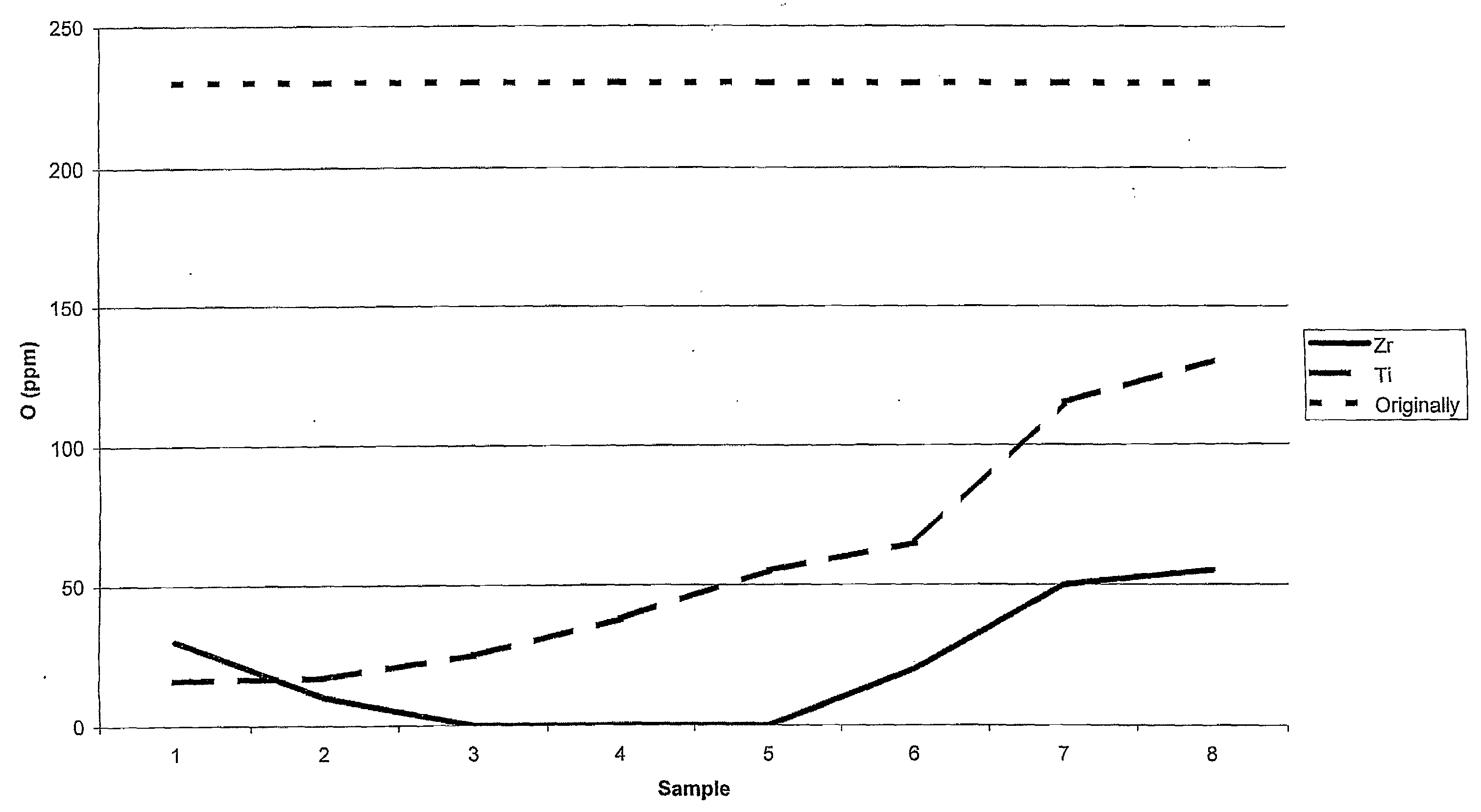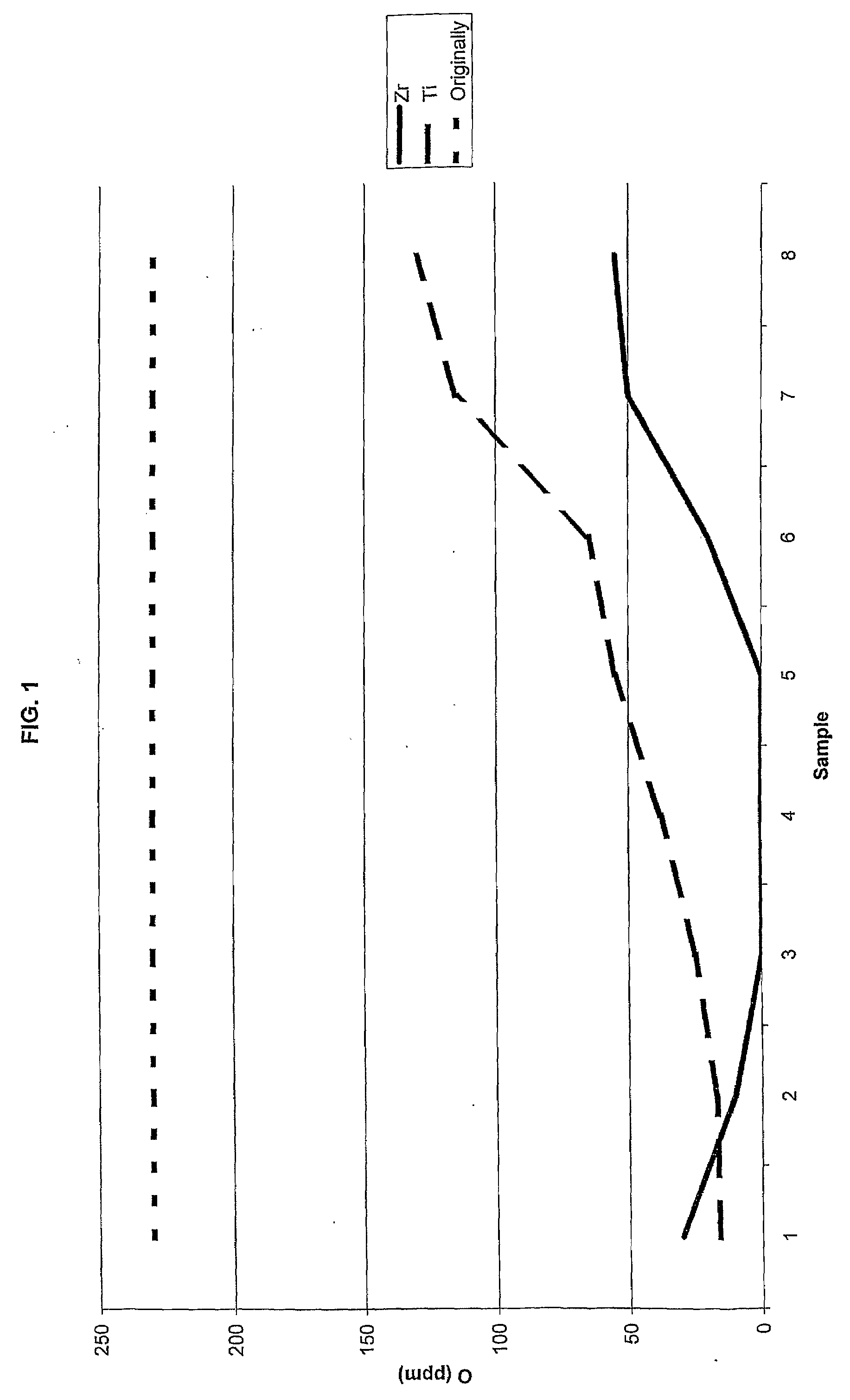Method of Controlling the Oxygen Content of a Powder
a technology of oxygen content and powder, which is applied in the direction of metal-working apparatus, transportation and packaging, thin material processing, etc., can solve the problems of unintentional oxidation of the surface of powder during production, deterioration of mechanical properties of a component, and general low impact strength of dense bodies of powder metallurgy. , to achieve the effect of reducing the oxygen content of powder
- Summary
- Abstract
- Description
- Claims
- Application Information
AI Technical Summary
Benefits of technology
Problems solved by technology
Method used
Image
Examples
example 1
[0033]Two powders produced by nitrogen-gas atomisation were tested. The composition of the powders are listed in Table 1, all in weight percent except oxygen which is in parts per million.
TABLE 1OAlloyCrNiMoMnSiCuCNppm126.26.23.00.580.541.80.0390.3230216.912.92.41.060.60—0.0210.17155
[0034]2-mm mild steel canisters with a dimension of 92×26×150 mm were utilised. The interior of the 92×150 mm walls of the canisters were attached with 0.125 mm metal foils of Ti by spot-welding.
[0035]All canisters were filled with powder, evacuated and sealed according to standard procedure. Canisters with Ti-foil getter were treated according to the method described above. First, the heating was carried out rapidly up to 500° C., subsequently at a rate of 5° C. / min up to a, in advance, chosen reduction temperature with a holding time of 60 minutes. Thereafter, the temperature was set to 900° C. and the environment outside the canisters was changed from hydrogen to argon. After 1 hour, the furnace heati...
example 2
[0037]Two large canisters of 2 mm mild steel plate were produced with a diameter of 133 mm and a height of 206 mm. In this case, a 0.125 mm thick titanium foil and a 0.025 mm zirconium foil were attached to the inside of the envelope walls, respectively. The canisters were filled with Alloy 1 of Table 1, evacuated and sealed according to standard procedure. The canisters were subjected to the method described above with the following parameters: heating at 1.4° C. / min in hydrogen up to 1100° C.; holding at 1100° C. during 9 hours; changing to argon flow and slow cooling down to room temperature (The cooling rate was 1.3-1.7° C. / min down to 700° C.). Thereafter, HIP was performed at 1150° C. and 100 MPa during 3 hours.
[0038]Slices of 5 mm were cut out from the densified canisters approximately 4 cm from the top. Thereafter, eight double samples were cut out in the radial direction from the surface to the centre of the slices. The results, for the canister with Zr getter, are presente...
example 3
[0041]The impact strength of the different specimens from Examples 1 and 2 was tested along with two comparative specimens where the method was not executed. Specimens of 10×10×55 were cut out from the produced test materials. From the canister of Example 2 with Zr-foil, specimens were cut out in the radial region having approximately zero ppm oxygen.
[0042]The specimens of Alloy 2 were annealed at 1050° C. for 60 minutes and then quenched in water. Specimens of Alloy 1 were annealed at 1080° C. for 60 minutes. Some of these specimens were quenched in water and others were cooled with controlled rate of 1-2.3° C. / second through the temperature interval 900-700° C.
[0043]Notch cutting and Charpy notch impact test was performed. For the specimens of Alloy 2 the temperature of the impact tests was −196° C. and the temperature for Alloy 1 was −50° C. The results are presented in Table 5, wherein the Charpy notch impact energy is presented as an average of two specimens and Q stands for qu...
PUM
| Property | Measurement | Unit |
|---|---|---|
| temperature | aaaaa | aaaaa |
| temperature | aaaaa | aaaaa |
| partial pressure | aaaaa | aaaaa |
Abstract
Description
Claims
Application Information
 Login to View More
Login to View More - R&D
- Intellectual Property
- Life Sciences
- Materials
- Tech Scout
- Unparalleled Data Quality
- Higher Quality Content
- 60% Fewer Hallucinations
Browse by: Latest US Patents, China's latest patents, Technical Efficacy Thesaurus, Application Domain, Technology Topic, Popular Technical Reports.
© 2025 PatSnap. All rights reserved.Legal|Privacy policy|Modern Slavery Act Transparency Statement|Sitemap|About US| Contact US: help@patsnap.com


